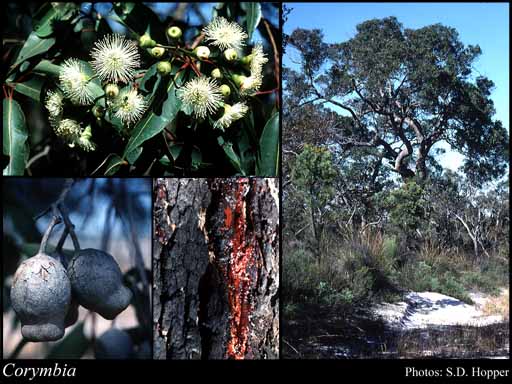- Reference
- Telopea 6:214 (1995)
- Name Status
- Current

Scientific Description
Common name. Eucalypts. Family Myrtaceae.
Sometimes included in Eucalyptus.
Habit and leaf form. Tall trees (to low mallees, bark persistent, shortly fibrous-flaky, parting in small polygons, or smooth, excorticating in polygonal flakes or short strips); evergreen; bearing essential oils. To 5–40 m high. Leptocaul. Helophytic to xerophytic. Heterophyllous (the mature crown of some species composed of juvenile leaves). Leaves medium-sized to large; opposite; ‘herbaceous’, or leathery; more or less sessile, or petiolate; connate, or not connate; gland-dotted, or not gland-dotted (apparently); aromatic; edgewise to the stem, or with ‘normal’ orientation; simple; epulvinate. Leaf blades dorsiventral, or isobilateral; entire; flat; linear, or lanceolate, or oblong, or ovate; ovate (or falcate); pinnately veined, or parallel-veined, or one-veined; cross-venulate. Mature leaf blades adaxially glabrous, or pubescent; abaxially glabrous, or pubescent. Leaves without stipules; without a persistent basal meristem. Leaf anatomy. Hairs present, or absent. Stem anatomy. Secondary thickening developing from a conventional cambial ring. Xylem vessels grouped. Paratracheal parenchyma confluent.
Reproductive type, pollination. Fertile flowers hermaphrodite. Unisexual flowers absent. Plants hermaphrodite. Entomophilous, or ornithophilous. Pollination mechanism unspecialized.
Inflorescence and flower features. Flowers aggregated in ‘inflorescences’; in umbels ((3-)7(-11)-flowered). Inflorescences compound. The terminal inflorescence unit cymose. Inflorescences terminal, or axillary; forming expanded terminal or lateral panicles or thyrsoids, sometimes metabotryoids, often extensively branched. Flowers pedicellate; (bi) bracteolate, or ebracteolate; small to large; operculate (calyptrate) (the operculum patelliform to shortly conical, comprising calyx and corolla); regular; cyclic. Free hypanthium present. Perianth with distinct calyx and corolla; 8, or 10; 2 -whorled; isomerous. Calyx present; 4–5; 1 -whorled; gamosepalous; entire; calyptrate; shed before the corolla, or not shed before the corolla; imbricate, or valvate; regular; persistent, or not persistent. Corolla present; 4–5; 1 -whorled; more or less polypetalous, or gamopetalous; entire; calyptrate, or not calyptrate (but then the free petals adherent to the calyx); integrally fused-calyptrate, or not integrally fused-calyptrate; imbricate; regular. Androecial members indefinite in number. Androecium 20–150 (‘many’). Androecial members branched. Androecial sequence determinable, or not determinable. Androecial members maturing centripetally; free of the perianth; all equal, or markedly unequal; free of one another. Stamens 20–150 (‘many’); polystemonous; inflexed in bud. Anthers dorsifixed; versatile; dehiscing via longitudinal slits; introrse; oblong or oblong-obovate; tetrasporangiate; appendaged (gland large), or unappendaged. Gynoecium 2–4 carpelled. The pistil (2–)3(–4) celled. Gynoecium syncarpous; eu-syncarpous; inferior. Ovary plurilocular; (2–)3(–4) locular. Epigynous disk present. Gynoecium stylate. Styles 1; apical. Styles straight in bud, or bent in bud (in section Cadagaria). Stigmas 1; shaggy or tapered, with short or long papillae. Placentation axile. Ovules 20–50 per locule (i.e. ‘many’); ascending; non-arillate; hemianatropous.
Fruit and seed features. Fruit non-fleshy; dehiscent; a capsule (urceolate to globular, deeply sunken in the hypanthium, disc depressed, valves 3 or 4, enclosed). Raphe of hemitropous type absent. Raphe of anatropous type absent. Seeds non-endospermic; laterally or dorsiventrally compressed; winged, or wingless. Seed wings not encircling body. Cotyledons 2; reniform. Testa not cracking, or cracking; with a crystalliferous layer.
Special features. Juvenile leaves all petiolate, or sessile or subsessile at some stage. Leaves never tightly cordate, subpeltate or peltate, or tightly cordate, subpeltate or peltate at some stage of the juvenile leaf succession. Adult leaves with many lateral veins; with an intramarginal vein distinct from the thickened margin, or with no distinct intramarginal vein. Oil glands without radiating hairs, or with radiating thin-walled blunt-ended hairs. Protuberant oil glands with 4 cap cells. Oil-gland cap cells ornamented. Thin-walled blunted-ended hairs present, or absent. Hairs unicellular or absent. Bristle-glands present. Pith of leafy twigs with large oil ducts. Inflorescence phyllotaxy fixed opposite. Corolla not congenitally fused with the calyx. Stigmatic papillae long, or short. Placental columella persisting in the open fruit, or falling (in section Cadagaria). Ovules randomly closely packed over the carpel surface. Inner integument not resorbed in seed (partially resorbed). Outer integument 4 cells thick. Not hosting Glycaspis subgenus Glycaspis.
Geography, cytology, number of species. Native of Australia. Not endemic to Australia. Australian states and territories: Western Australia, South Australia, Northern Territory, Queensland, New South Wales, Victoria, and Australian Capital Territory. Northern Botanical Province, Eremaean Botanical Province, and South-West Botanical Province.